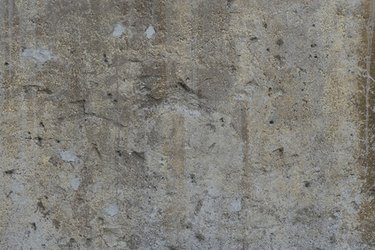
If you would like to enhance the appearance of a bare cement wall, you can accomplish your goal by applying the appropriate type of paint. Because cement walls are poorly-suited for paint adhesion, you will need to condition them prior to paint application, or you will end up with a finish that will eventually chip and peel. In addition, you should choose a particular type of paint, depending on whether the wall is located indoors or outdoors.
Cleaning
Video of the Day
Primer and paint will not bond to dirty cement walls. Exterior walls should be cleaned using a pressure washer prior to application. Interior cement walls, like those found in basements, can be scrubbed with a mop.
Video of the Day
Protection
Primer and paint drips and splatters can permanently damage certain types of flooring. You should take the time to meticulously cover flooring and other surrounding surfaces with heavy-duty fabric dropcloths and a low-tack painter's tape.
Interior Walls
Satin latex paint is appropriate for coating interior cement walls. Those who desire a glossier coating may decide to choose a paint with a semigloss sheen. Flat latex paints are not suitable for interior cement walls, because they are prone to staining and difficult to clean.
Exterior Walls
Acrylic latex paint is appropriate for coating exterior cement walls, because it possesses enough elasticity to contract and expand in varying weather conditions and temperatures.
Primer
Cement walls require a base coat of primer prior to painting. Paint will eventually shed from unprimed walls. Coat interior cement walls with a latex primer. Coat exterior cement walls with an acrylic latex primer.
Safety
Safety equipment is generally not required when painting exterior cement walls. However, you should wear a respirator when painting walls within basements that provide poor ventilation. If you need to use a ladder to access higher portions of a cement wall, read the safety guide on the side of the ladder to minimize the risk of injury.